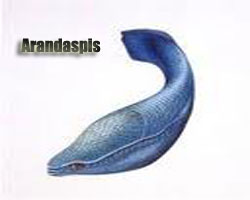Arandaspis

Science Name
Prionotolepis
Description
In 1959, fossils of 4 distinct types of fish were discovered south of Alice Springs, in the heart of the Australian continent.The name of Arandaspis was given to the best-preserved specimens.This was Created to celebrate the aboriginal Aranda tribe of the area, and to reflect the fish's bony head covering in Greek aspis means "shield."It has jawless mouth was on the underside of its head, suggesting that it may have fed on or near the seabed.
Habitat
"Its lower body was covered in oblique rows of small bony scales, each shaped like a cowrie shell,and decorated with pointed tubercles, which must have given the skin a rough, abrasive texture, like that of a shark."
Behaviour
It has a streamlined,deep bodied shape.With no fins to stabilize it. Its lower body was covered in oblique rows of small bony scales which gives the skin a rough, abrasive texture.
Life History
They were entombed in marine sandstones, laid down in a shallow sea about 500 million years ago. It was not until the late 1960s that these remains were recognized as belonging to the earliest- known vertebrates.
Region Found
Australia (Northern Territory)
 Deep Sea Crabs
Deep Sea Crabs